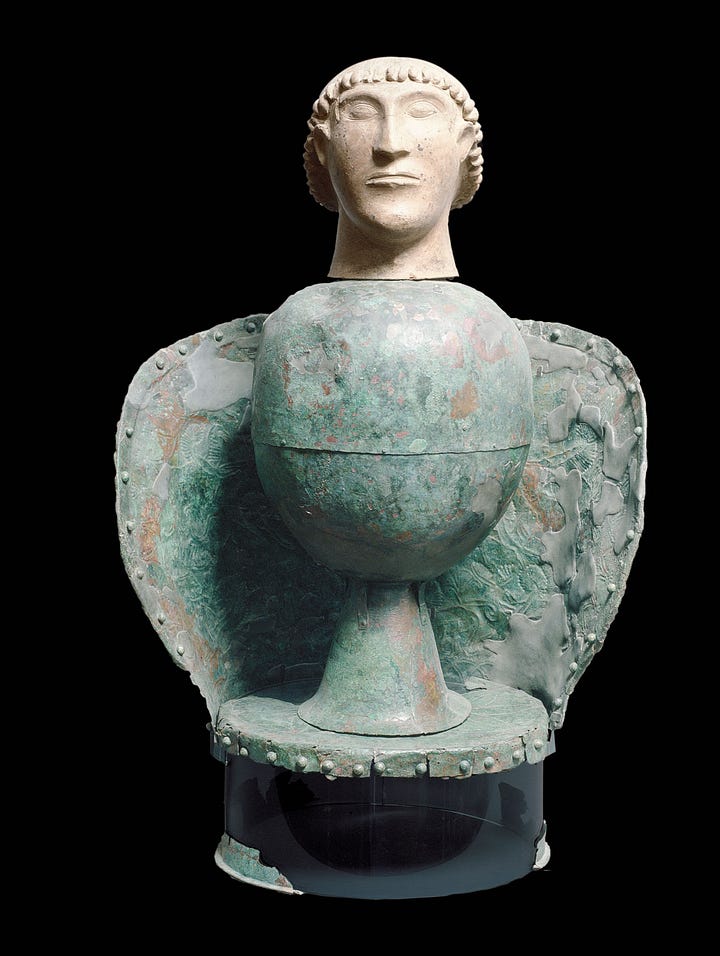Fresh Batch #94: The Etruscan City Clusium
The Origin of an Ancient Cross and the German & Scandinavian Runes
Clusium’s art emphasized grotesque forms, almost akin to Picasso. It is reminiscent of sculptures found in Sardegna.



They also implemented the use of sarcophagi, which may indicate a strong relationship with Egypt. The people of Clusium were also fond of urns and jars with human heads as lids.





Their city walls are only 64 acres and indicate that they did not farm inside of it, meaning they were not agricultural. What is known about them is mostly found in their cemeteries and tombs. According to Wiki, the Situla of the Pania is an ivory situla or pyxis from the end of the seventh century BC, found in the Tomb of the Pania in Chiusi and conserved in the Museo archeologico nazionale di Firenze.
The work is one of the most important examples of Etruscan ivory work - there are only two other examples, one from Chiusi and one from Cerveteri. It is composed of a hollow cylinder (22 cm high) and decorated with horizontal friezes, separated by small bands carved with plant motifs (interweaved palmettes and lotus flowers). Two medium-sized bands at the top and bottom are decorated with more lotus flowers.



The upper frieze shows two myths from the Odyssey, split by a sphinx: the encounter with Scylla (who looks a lot like a hydra) and the escape from the cyclops Polyphemus. The second frieze shows common motifs of departure for war, followed by hoplites performing a salute and weeping women (with long braids and their arms over their chests). After that there is a warrior without his shield performing a funerary dance and a horseman. The third band is decorated with beasts and monsters, employing eastern motifs. On the final band there are further imaginary animals.
The origin of the silver vase is uncertain. Some think it is from Caere while others think it is from Phoenicia, but Grant thought that its northern situla form suggests its place of origin may be Clusium, where it was found. (The Etruscans, p. 203.)
There are symbols on the following pottery that predate the history of its use in every other culture with the exception of Greece (should the dating be accurate), unless I am mistaken. It was found in Clusium. The symbol exists in two forms on the same piece. The version on the upper portion of this pottery is unique to Italy as far as I can tell (I’ve seen it on other Etruscan artifacts, but the closest variant beyond that is a Germanic version. However, Futhark comes from Etruscan (Italian), so it supports my suspicion of the Germanic/Scandinavian people being a diaspora from Italy or southern Europe, be it by way of Britain or through Slovenia, not originating in the north or east and then migrating to Italy). The version of the swastika on the lower portion of this pottery is found in Europe, the Americas, and Asia long before the boot boys and mean Mr. Mustache hijacked it. It is without a doubt diffusion, and I suspect it originated in Italy, not Greece, on account of the chronology of Etruria being erroneously dated, or the rest of Mediterranean civilization being erroneously dated in relation to Etruria.
Here’s the closest version of it I’ve come across, but perhaps you can post links in the comments to contribute or correct. This is allegedly Hiberno-Saxon.
According to Wiki, the Oseberg ship (Norwegian: Osebergskipet) is a well-preserved Viking ship discovered in a large burial mound at the Oseberg farm near Tønsberg in Vestfold og Telemark county, Norway. This ship is commonly acknowledged to be among the finer artifacts to have survived from the Viking Era.








Upon closer inspection, while archaeologists have done their best, they flip-flop enough to demonstrate that they are incapable of knowing much about the ship, or its history, beyond the obvious.


These all date around the same time as the Etruscan use of this symbol (if the dating can be depended on). You’ll notice the birds depicted alongside of them. These are symbols, specifically pelicans or storks, the very meaning signified by Pelasgos. Thus, the Holy Sailors (Dioi Pelasgoi) are signified. Well, who are the Pelasgi?
“Myrsilius of Lesbos does not call the people Pelasgians, but Tyrrhenians (Italians). And the same people were called by the rest of the world both Tyrrhenians (Italians) and Pelasgians.” Dionysius of Halicarnassus (1st century BC)
Scholars and philologists were wrong about the earliest Greek abecedaria, which turned out to be Etruscan. Why wouldn’t they be wrong about pottery and other symbolism?
If you’re intrigued by how this cultural diffusion is finding its way all over the world, the solution to your inquiry is the Etrusco-Phoenicians. To learn who they are, and who many of you descended from if you grew up near a port, dive into The Holy Sailors (click the image).
If reading isn’t your thing, give the audiobook sample a go. If you’ve never taken advantage of a free trial, you can do so and get The Holy Sailors for free (click the image).
Become a member to access the rest of this article.
Keep reading with a 7-day free trial
Subscribe to Ancient History, Mythology, & Epic Fantasy to keep reading this post and get 7 days of free access to the full post archives.












